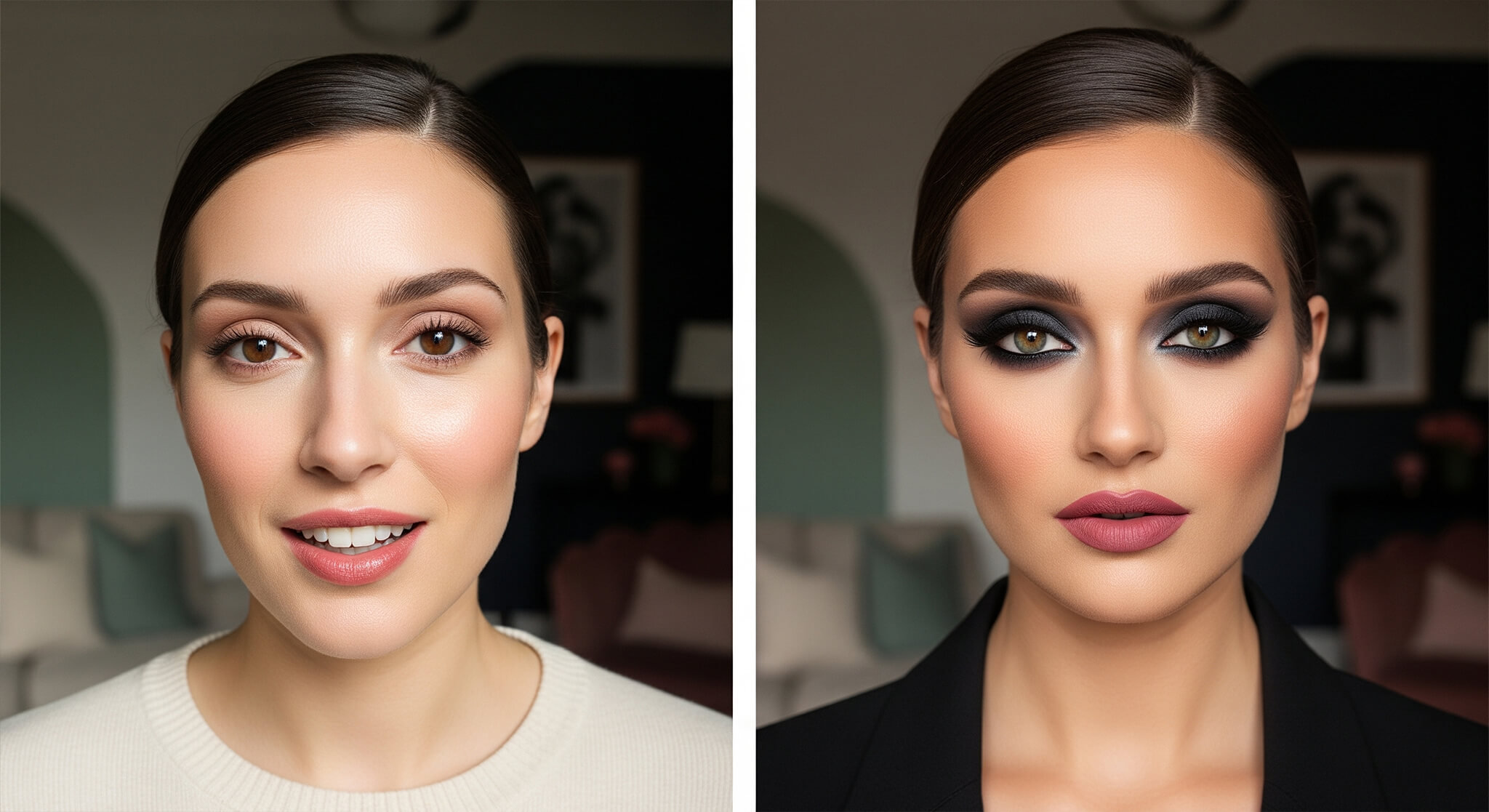The Ultimate Day-to-Night Makeup Transformation Guide
Table of contents
From Desk to Dinner: Your Quick-Change Artistry Guide
The workday is finally over, and a last-minute invitation for dinner or drinks pops up. It’s an exciting prospect, but the thought of your faded, 9-to-5 makeup can be deflating. There’s no time to go home and start all over again.
Meet Olivia. She used to dread after-work plans, feeling like her makeup looked tired and unprofessional by evening. But then she mastered the 15-minute transformation—a series of smart, strategic additions that elevate her look without redoing a thing.
This guide will teach you those same secrets. It’s not about starting from scratch; it’s about skillfully building upon the base you already have to create a polished, evening-ready look in minutes.
The Foundation of the Look: A Long-Lasting Daytime Base
A successful evening transformation begins in the morning. The key to a look that can be built upon is makeup longevity.
It Starts with Primer
Before you apply any makeup in the morning, use a high-quality Primer. This creates a smooth canvas and gives your foundation something to grip onto, ensuring it lasts well past 5 PM without sliding or settling.
The Right Foundation & Setting Technique
Opt for a long-wearing, satin-finish Foundation. It’s the perfect middle ground—not so matte that it will look cakey when you touch it up later, and not so dewy that it will disappear by midday. In the morning, set your makeup with a light dusting of translucent powder on your T-zone and a generous mist of setting spray to lock everything in place for the day ahead.
Your 15-Minute Transformation Toolkit: What to Pack
A successful transformation requires a well-edited makeup bag. Here are the essentials:
- Blotting Papers or a Pressed Powder Compact
- Your go-to Concealer
- A small eyeshadow quad (with at least one deep, matte shade and one shimmer)
- A dark Eyeliner pencil (black, brown, or charcoal)
- Mascara
- A bold or deep Lipstick
- A travel-sized setting spray
The Step-by-Step Guide: From Day to Night in Minutes
Step 1: Refresh Your Base (2 Minutes)
Crucial rule: Do not add another layer of foundation. First, use blotting papers to gently absorb any excess oil from your T-zone. Then, spritz your face with a setting spray or hydrating mist. While your skin is still slightly damp, use a clean finger or a corner of a makeup sponge to press and blend any areas where makeup has settled or creased. Finally, add a tiny dot of Concealer under the eyes or around the nose only if absolutely necessary.
Step 2: Intensify the Eyes (7 Minutes)
This is where the real transformation happens.
- Add Depth: Take the darkest matte shade from your eyeshadow quad on a fluffy brush and blend it into your crease and the outer corner of your eye, right over your daytime shadow.
- Define with Eyeliner: Apply a dark Eyeliner pencil along your upper lash line, getting close to the roots. Use your finger or a small brush to smudge it slightly for a soft, smoky effect. For extra drama, add a little to the outer third of your lower lash line.
- Add a Pop of Shimmer: Use your fingertip to press a shimmery eyeshadow shade right onto the center of your eyelid. This catches the light beautifully in evening settings and instantly makes your eyes look more vibrant.
- Boost Your Lashes: Apply a second, generous coat of mascara, wiggling the wand at the base of your lashes to build volume and length.
Step 3: Sculpt and Glow (3 Minutes)
Layer powder products over your faded daytime makeup to bring it back to life and add dimension for evening lighting.
- Sweep a powder blush over the apples of your cheeks and a bronzer where the sun would naturally hit. To elevate the look, dust a powder highlighter on the high points of your face: top of the cheekbones, brow bone, and the bridge of your nose.
Step 4: The Bold Lip (2 Minutes)
This is the fastest and most impactful way to signal a shift from day to night.
- Carefully apply a bold or deep Lipstick—think a classic red, a rich berry, or a sophisticated plum. A statement lip instantly adds polish, confidence, and glamour.
Step 5: Set for the Night (1 Minute)
Hold your setting spray about eight inches from your face and give it a final, generous mist. This will meld all the new powder and cream layers together, remove any ‘powdery’ look, and lock in your makeup for the rest of the night.
Day-to-Night Makeup FAQ
How do I fix creased eyeshadow or concealer before my touch-up?
Before adding any new product, use the warmth of your clean ring finger or a damp sponge to gently tap and blend out any creases in your under-eye concealer or eyeshadow. This creates a smooth surface to work on.
What’s better for a quick change: a smoky eye or a bold lip?
If you have less than 5 minutes, a bold lipstick is the single most effective change you can make. If you have 10-15 minutes, doing a quick smoky eye and a bold lip creates a classic, glamorous evening look.
How do I prevent my makeup from looking cakey when I add more product?
The secret is to blot excess oil first, then rehydrate the skin with a face mist before touching up. And remember the golden rule: add product sparingly. A little extra concealer or powder goes a long way.
What’s your secret weapon for a quick day-to-night makeup change? Share your favorite product or tip in the comments below!
